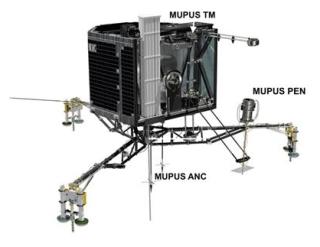Jul 31 2015
Comet Churyumov-Gerasimenko poses new riddles: Surface material measurements performed by the «Philae» landing module indicate that the near surface material might have changed since its formation. Up to now, many researchers had assumed that it has remained in virtually the same state since its formation about 4.5 billion years ago. The results of the study, in which researchers from the University of Bern were also involved, have been published in «Science» magazine.
 MUPUS on the Rosetta lander «Philae». The MUPUS PEN(etrator) was deployed to a distance of about 60 cm after Philae had landed. The hammer mechanism on top of the probe was supposed to insert the thin rod - equipped with temperature sensors - into the comet’s surface. The surprisingly hard surface was able to withstand the strong hammer and prevented the probe insertion. © ESA / ATG media lab
MUPUS on the Rosetta lander «Philae». The MUPUS PEN(etrator) was deployed to a distance of about 60 cm after Philae had landed. The hammer mechanism on top of the probe was supposed to insert the thin rod - equipped with temperature sensors - into the comet’s surface. The surprisingly hard surface was able to withstand the strong hammer and prevented the probe insertion. © ESA / ATG media lab
Hard like frozen firn snow instead of loose and soft like dust: Apparently, the material under the surface of Comet Churyumov-Gerasimenko is far harder than many experts had expected – this was the result from measurements by the «Philae» comet lander at least. Karsten Seiferlin, planetologist and project manager at the Physics Institute at the University of Bern, was directly involved in the discovery and is the co-author of a «Science» article, in which the measurement results were published. «The solidification of the material indicates processes, which have sustainably changed the comet or are still changing it», he says.
These findings are very significant for the Rosetta mission, «It was originally assumed that comets have remained virtually unchanged since their formation, thus providing information about the formation of planets and comets.» However, the latest results from the «Rosetta» mission have now showed that the possibility of changes needs to be taken into consideration.
According to Seiferlin, an initial indication of a hard layer near to the surface has already resulted from the surprisingly high and far jump, which Philae made after the initial contact with the comet during its dramatic landing in November 2014. Direct evidence of the hard layer was then provided by the MUPUS instrument, which Seiferlin supervised as a project manager from 1994 to 2002 – back then still at the Institute of Planetology at the University of Münster. The actual aim of the instrument was to hammer an approx. 35 cm long rod equipped with temperature sensors (MUPUS PEN) into the ground using a hammer mechanism in order to measure the temperatures below the surface.
Philae’s hammer did not break through
But not everything went smoothly: The instrument initially worked without any errors and exactly as planned. It put the temperature sensor about 60 cm away from Philae, where the hammer then began its task and tried to hammer the measuring rod into the comet soil. When no progress was seen, the hammer’s capacity was automatically increased to the maximum force. Although the highest hammer setting was sufficient on Earth to crack aerated concrete stone or very solid snow, the planned penetration on Churyumov-Gerasimenko ultimately failed because of the unexpected hardness of the comet soil.
According to Karsten Seiferlin, the reasons for the observed hardness are unclear. It’s possible to consider both relatively recent processes, which are propelled by the strong radiation close to the sun, and far-back processes which are connected to the formation and development of Churyumov-Gerasimenko. «The comet has had 4.5 billion years to change.»
A comet with amnesia
Now the scientists say it is particularly important to understand these changes as the ESA Rosetta space probe seems to be orbiting a comet, which has undergone at least some degree of modification compared to its initial state. Seiferlin: «The hoped-for witness to the formation of the solar system is suffering, as it were, from amnesia.» Therefore, the statements made have to be carefully evaluated. «Like almost every time that space probes examine an as yet unknown body, everything was different to expected. Nature surprises us repeatedly and leaves us with more questions than we had before.»
Source: http://www.unibe.ch/